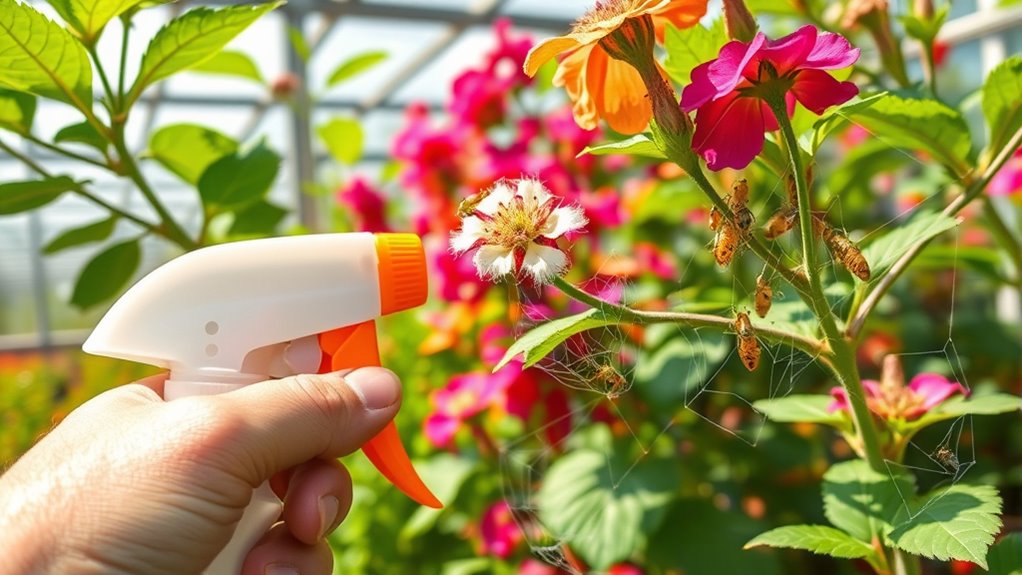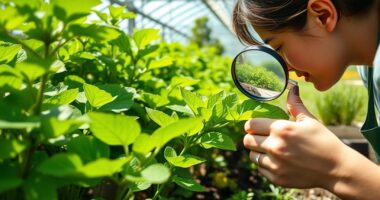Common pests in greenhouses include aphids, whiteflies, spider mites, mealybugs, and fungus gnats. To control these pests, monitor plants regularly for early signs of damage. You can use physical controls like sticky traps, biological controls such as beneficial insects, or chemical treatments when necessary. Managing moisture helps reduce fungus gnats, while quick action against aphids and whiteflies prevents infestations. There’s more to learn about effective strategies to keep your greenhouse healthy and thriving.
Key Takeaways
- Regularly inspect plants for signs of aphids, whiteflies, mealybugs, and fungus gnats to catch infestations early.
- Use sticky traps to monitor and control fungus gnat populations effectively.
- Implement proper watering techniques to prevent overwatering, which attracts fungus gnats.
- Introduce beneficial insects like ladybugs and predatory mites to manage aphid and whitefly populations naturally.
- Apply insecticidal soap or neem oil for targeted treatment of infestations on affected plants.
Overview of Common Greenhouse Pests

When you manage a greenhouse, it’s crucial to recognize common pests that can threaten your plants.
Aphids, small and soft-bodied, reproduce quickly and can spread viruses, while whiteflies suck sap, leading to stunted growth and discoloration.
Spider mites, tiny and oval-shaped, cause stippling and chlorosis as they feast on plant sap.
Fungus gnats, small and winged, often hang around moist areas and can carry soil-borne diseases.
Lastly, thrips are tiny insects that damage plants and spread diseases.
Understanding these pests helps you take action before they wreak havoc on your greenhouse.
Identifying Aphids and Their Impact
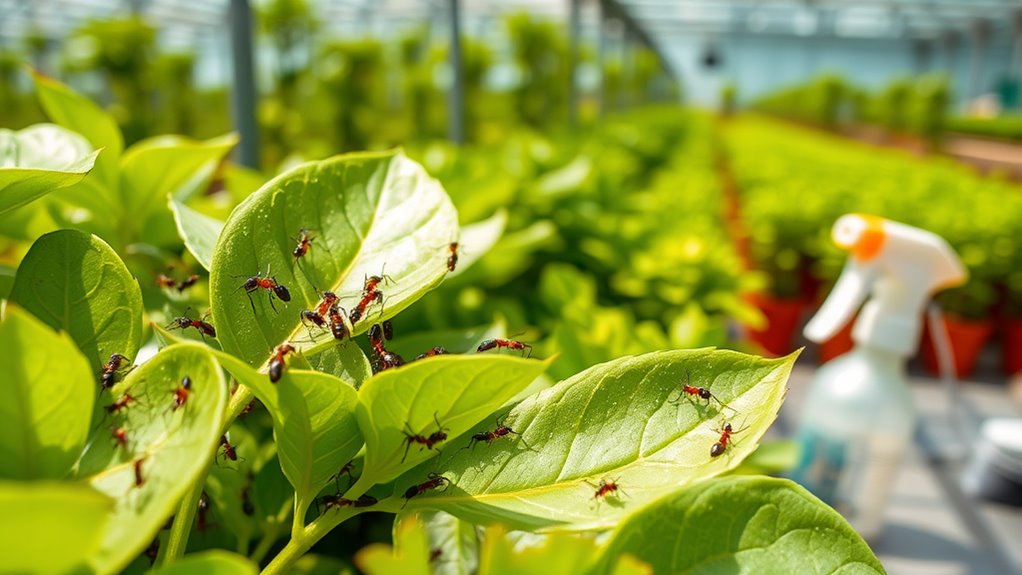
Aphids are notorious pests that can cause significant harm to greenhouse plants. These small, soft-bodied insects typically measure less than 1/8 inch long and come in various colors like greenish-yellow, dark green, brown, black, and pink.
Aphids are small, damaging pests that threaten greenhouse plants with rapid reproduction and diverse color variations.
Look for their distinctive cornicles at the end of their abdomen and note that some have wings, held vertically when not in use. Aphids often form large colonies on new growth and the undersides of leaves.
Their feeding damages plants, causing curled leaves and reducing quality. They also excrete honeydew, promoting sooty mold growth, and can transmit viral diseases.
With rapid reproduction, aphid populations can explode, making early identification and control crucial for your greenhouse health.
Understanding Whiteflies and Their Damage
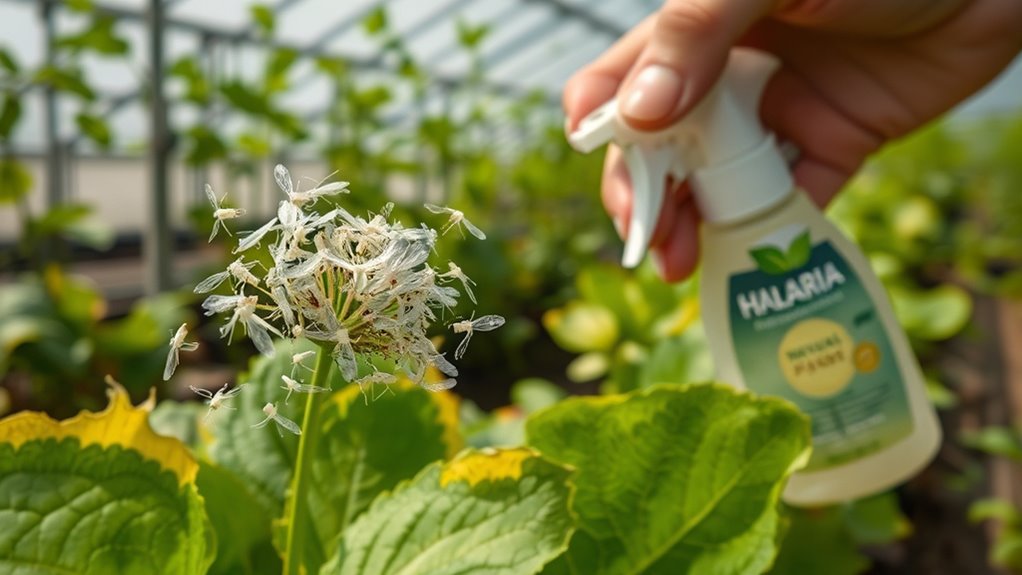
Whiteflies are among the most challenging pests you’ll encounter in your greenhouse, with two primary species—the greenhouse whitefly and the sweet potato whitefly—commonly causing trouble.
These small, white insects feed on the undersides of leaves, weakening your plants by sucking their sap. This not only reduces their vigor but also impacts their marketability.
Moreover, whiteflies excrete honeydew, leading to sooty mold that further damages plant quality. Their rapid reproduction, with females laying up to 400 eggs, can quickly escalate infestations.
Infested plants become more vulnerable to diseases and secondary infections, threatening your entire crop.
To safeguard your greenhouse, understanding whiteflies and their damaging effects is crucial for effective pest management.
Recognizing Mealybugs and Their Effects
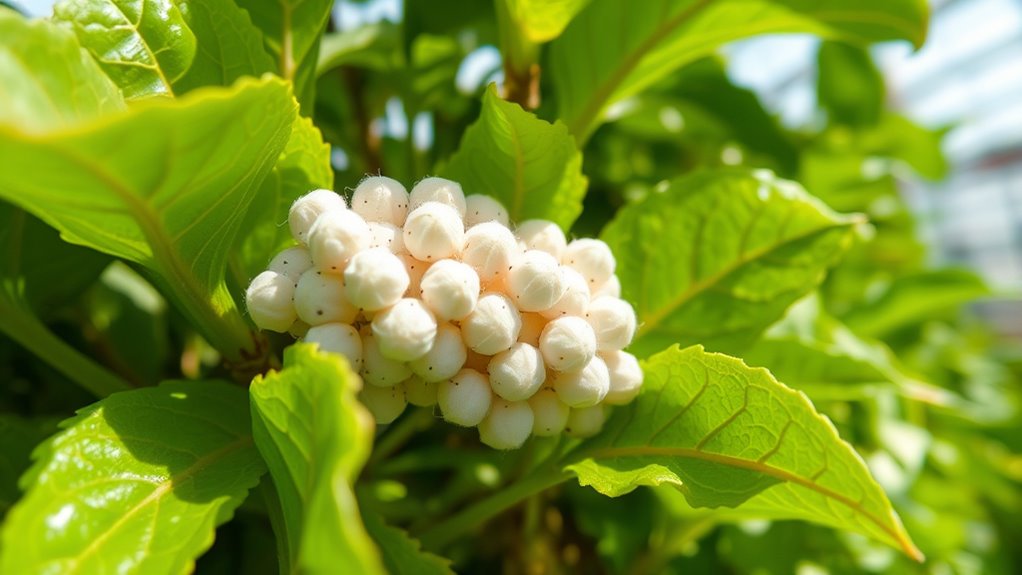
Though often overlooked, mealybugs can wreak havoc in your greenhouse if left unchecked. These small pests, about 1/8 inch long, are covered in a white, waxy powder and can be spotted on leaf undersides, petiole junctions, and plant bases.
They use piercing-sucking mouthparts to extract fluids, resulting in stunted growth, yellowing leaves, and distorted plant parts. Additionally, mealybugs excrete honeydew, leading to black sooty mold that hinders photosynthesis.
You might find them in cracks, crevices, and even on nearby plants. Their presence can significantly reduce plant quality and marketability, so it’s crucial to regularly inspect your plants and act quickly if you spot these pests.
Early detection and control are key to protecting your greenhouse.
The Threat of Spider Mites in Greenhouses
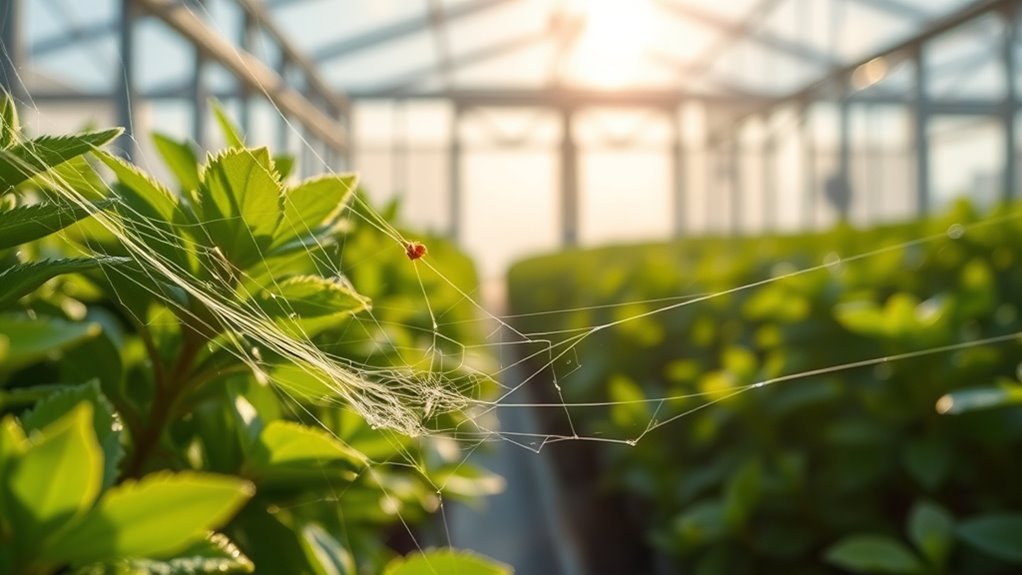
While mealybugs are a significant concern in greenhouses, spider mites also pose a serious threat to your plants.
These tiny pests, especially *Tetranychus urticae*, can feed on over 300 plant species, causing significant damage. Their life cycle lasts about 7 to 14 days in warm, dry conditions, leading to rapid population growth.
You might notice chlorotic spots or stippling on leaves, which reduces plant quality and yield. Adult spider mites are small, oval-shaped, and often produce silk webs as their numbers increase.
Regular inspections are crucial; check the undersides of leaves and look for webbing. Maintaining humidity and promptly removing infested plants can help manage these pests effectively.
Managing Fungus Gnats and Their Lifecycle

Managing fungus gnats effectively is crucial for maintaining healthy plants in your greenhouse. These small pests, resembling mosquitoes, can cause significant damage, especially to young seedlings and cuttings.
Their lifecycle—from egg to adult—takes just 3 to 6 weeks, with overlapping generations making control challenging. You’ll often find their shiny, white eggs in the top layer of the soil, while the larvae feed on plant roots, leading to wilting and yellowing.
To manage them, ensure you avoid overwatering and remove any decaying plant material. Additionally, consider using beneficial nematodes or Bacillus thuringiensis to target larvae.
Avoid overwatering and eliminate decaying plant material; consider beneficial nematodes or Bacillus thuringiensis to effectively target larvae.
Regular monitoring with yellow sticky cards can help you keep track of their presence and population.
Physical Control Methods for Greenhouse Pests

To effectively combat pests in your greenhouse, employing physical control methods can make a significant difference.
Start by using insect netting on vents and sealed openings to keep pests out while maintaining airflow. Consider floating row covers to protect your plants and exclude insects, but remember to accommodate pollination.
Plastic mulch serves as a barrier against pests and aids in disease control. Trapping methods like sticky traps and pheromone traps can help monitor and manage pests effectively.
For manual removal, hand-picking and vacuuming are great options. Lastly, adjust environmental factors like temperature and humidity to deter pest populations.
Biological Control Strategies to Combat Infestations

Biological control strategies harness the power of living organisms to keep pest populations in check, offering an eco-friendly alternative to chemical methods.
You can use various agents like predatory mites, parasitic wasps, and beneficial nematodes to target specific pests in your greenhouse.
Integrating these strategies into your integrated pest management (IPM) plan boosts effectiveness.
It’s essential to consider environmental conditions since many biological agents require specific temperature and humidity levels to thrive.
While it may take longer to see results compared to chemicals, the long-term cost-effectiveness of biological control is significant.
Encourage natural enemies, introduce new beneficial species, and plan seasonal releases to maintain a balanced ecosystem that keeps pests at bay.
Chemical Control Options and Application Techniques

While biological control strategies offer a sustainable way to manage pests, sometimes you may need to turn to chemical control options for a more immediate impact.
Broad-spectrum pesticides like organophosphates can be effective, but consider newer alternatives like spinosad for safer options. For fungal issues, strobilurins work well with short re-entry intervals.
Timing is crucial; apply chemicals during pests’ most vulnerable life stages and ensure correct dosages to prevent resistance. Use targeted applications to minimize environmental impact and rotate products regularly.
Always follow safety guidelines to protect yourself in enclosed spaces.
Integrating these chemical methods with other strategies, like monitoring and cultural practices, can enhance overall pest management in your greenhouse.
Frequently Asked Questions
What Are the Best Preventive Measures for Greenhouse Pests?
To prevent greenhouse pests, you should start with insect screens on air intakes to block entry.
Ensure proper ventilation to reduce humidity and maintain a clean environment by regularly cleaning surfaces.
Create vegetation-free zones around the greenhouse to limit pest migration.
Implement crop rotation and quarantine new plants to avoid introducing pests.
Lastly, consider introducing beneficial insects and keeping a close eye on your plants for early signs of trouble.
How Often Should I Inspect My Greenhouse for Pests?
Imagine a vigilant gardener, eyes scanning every leaf like a hawk, dedicated to protecting their green haven.
You should inspect your greenhouse weekly, but twice weekly’s even better during the growing season. Spend at least 10 minutes checking 20 or more plants for every 1,000 square feet.
Daily checks on indicator plants and sticky traps keep you ahead of any lurking threats, ensuring your plants thrive in a healthy environment.
Can Greenhouse Pests Affect Indoor Plants as Well?
Yes, greenhouse pests can definitely affect indoor plants.
If you bring in infested plants or if pests find their way inside, they can quickly spread.
You should always inspect your indoor plants regularly for signs of trouble, like distorted leaves or sticky residue.
Keeping your indoor environment clean and monitoring humidity levels will help reduce the likelihood of an infestation spreading from your greenhouse to your home plants.
What Environmental Conditions Attract Greenhouse Pests?
Imagine your greenhouse as a cozy haven for thriving plants, but lurking around are pests just waiting for the right moment to crash the party.
Temperature extremes, high humidity, and poor air circulation create a perfect storm for these unwelcome guests.
When you overwater or neglect ventilation, you’re rolling out the red carpet.
Stressful conditions make your plants vulnerable, inviting pests to settle in and multiply, leaving you to battle the aftermath.
Are There Any Natural Repellents for Greenhouse Pests?
Yes, there are several natural repellents you can use to deter greenhouse pests.
Garlic and onions release sulfur compounds that keep pests at bay, while basil’s essential oils effectively repel mosquitoes and flies.
Lavender and rosemary also help by warding off moths and mosquitoes.
Additionally, mint is great for keeping ants and other insects away.
Incorporating these plants not only enhances your greenhouse’s ecosystem but also provides a pleasant aroma.
Conclusion
In the battle against greenhouse pests, staying vigilant is your best ally. By identifying these nuisances early and employing a mix of control methods—be it physical, biological, or chemical—you can keep your plants thriving like a well-tended garden. Remember, a proactive approach not only prevents infestations but also nurtures a healthier growing environment. So, arm yourself with knowledge and watch your greenhouse flourish, free from the clutches of unwelcome pests!
